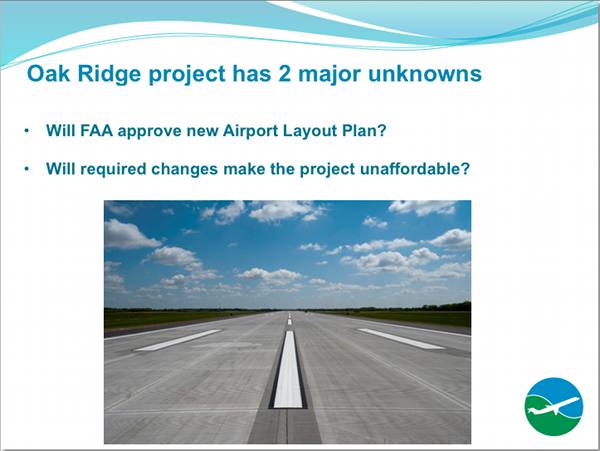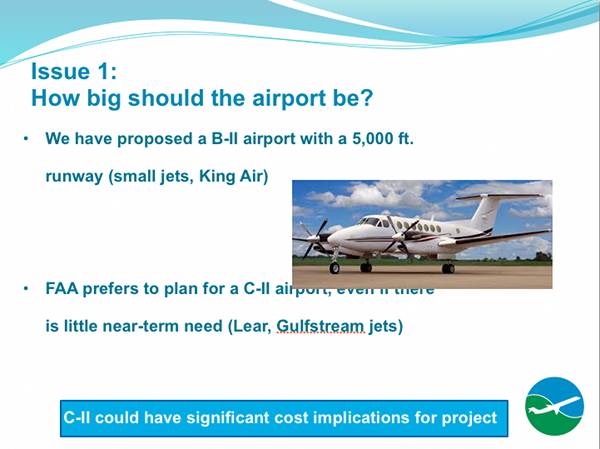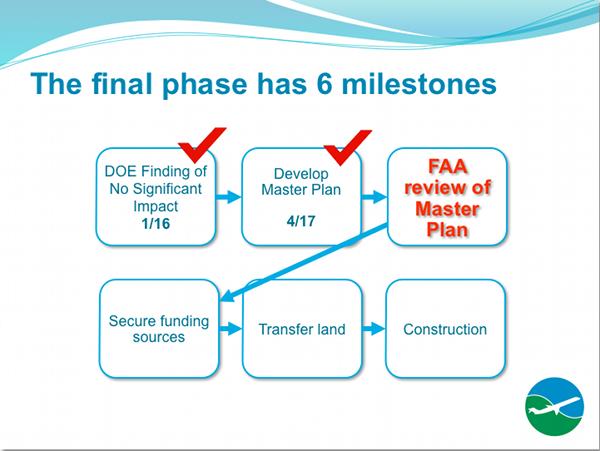
A revised layout plan for the Oak Ridge Airport at Heritage Center from a presentation to Oak Ridge City Council by project consultant Billy Stair on Feb. 20, 2018. (Image courtesy Billy Stair)
Officials working on the proposed Oak Ridge Airport could receive comments this week from the Federal Aviation Administration about a revised layout plan, a project consultant said Thursday.
Officials are finalizing an airport runway plan. If it is approved, that would be a very positive step, project consultant Billy Stair said.
In February, Stair said the FAA wanted project officials, who are proposing to build what is known as a Class B airport, to plan for a future expansion to a Class C airport—sometime around 2040.
“To plan for such a future expansion, we need to widen the runway and taxiway at the initial construction,” Stair said in February. “We do not need to lengthen the proposed 5,000-foot runway. The new runway alignment avoids encroachment by Highway 58.”
On Thursday, Stair said project officials need to plan for the possibility that bigger, faster planes could use the airport in the future. A presentation that Stair gave to Oak Ridge City Council in February said a B-II airport with a 5,000-foot runway could accommodate small jets and King Air aircraft, while planning for a C-II airport, even if there is little need at this time, could accommodate Lear and Gulfstream jets in the future.
If approved and funded, the Oak Ridge Airport would be built alongside Highway 58 on the south side of the Heritage Center, the former K-25 site in west Oak Ridge. It would be built on 170 acres of land that have been declared excess by the U.S. Department of Energy.
In February, Stair said the proposed runway at the airport had been moved a little to the north and several hundred feet to the west. The proposed terminal hangars and hangars were moved to the south side of the runway to allow easier access.
The proposed runway has been moved because the FAA doesn’t want any obstructions in runway protection zones. That includes highways such as Highway 58. Runway protection zones are trapezoidal areas along the runway approach and departure paths.
The FAA comments that could be received this week are expected to seek clarification on the revised airport layout plan and address such issues as safety and justification, Stair said Thursday. The board of the Metropolitan Knoxville Airport Authority will then respond to the comments.
Approval of the airport runway plan would be “very positive,” Stair said.
“That’s the signal that we can go forward with the design and environmental assessment,” he said.
DOE has completed an environmental assessment, so about 80 percent of that work is already done, Stair said.
There is a rough cost estimate of $46 million for the airport. The DOE land, which has not been given to the project yet, would be provided for free. The biggest expense, more than half of the estimated cost, would be moving dirt, Stair said.
In February, Stair said the original cost estimates were done carefully.
“But until we know exactly where FAA will permit the runway to be located it is impossible to provide a more accurate project cost estimate,” Stair said. “The largest single element of project cost involves moving dirt on a site that has a large hill as well as ravines on the north side. For example, the ability to move the terminal to a more level location on the south side of the runway should save costs. On the other hand, moving the runway west will require more fill than the previous estimate. We cannot determine a meaningful project cost until the precise location of all the items such as the runway, taxiway, terminal, hangars, utilities, and various roads is approved. We made clear to Council that it is possible FAA’s required changes will increase the project cost.”
On Thursday, Stair said officials have about $28 million “in hand,” and they believe they can get about $5 million more. So the project could require about $20 million from the FAA.
“That would be far less than they have spent on any other new general aviation airport in the last 30 years,” Stair said.
The FAA has included the project in the National Program of Integrated Airport Systems. That means it’s eligible for FAA funding, Stair said last year.

Two major unknowns for the proposed Oak Ridge Airport at Heritage Center as discussed during a presentation to Oak Ridge City Council by project consultant Billy Stair on Feb. 20, 2018. (Image courtesy Billy Stair)
Oak Ridge Today reported in December that Tennessee officials had appropriated $15 million that could be used for the proposed airport. The appropriation is pending approval of the Oak Ridge Airport by the Federal Aviation Administration. In December, the state appropriation was expected to be enough to cover about 33 percent to 38 percent of the estimated project cost at the time, about $40 million to $45 million.
Besides the FAA, other direct and indirect funding sources for the airport include the U.S. Department of Energy, which will provide the land; Appalachian Regional Commission; Tennessee Aeronautics Commission; and Tennessee Department of Transportation.
Stair has previously said there is no funding from the City of Oak Ridge or Roane County. (Heritage Center is in the Roane County portion of Oak Ridge.)
“There is no financial exposure for either the city or county,” Stair said.
Stair said the free land is very significant, and it could be the difference in this project. At most airports, land or site preparation is usually worth about $10 million, he said. The land in Oak Ridge will transfer as soon as the FAA gives the “green light” to the project, Stair said. The MKAA submitted an application to DOE for the transfer of 171 acres at Heritage Center in June 2013.

One issue for the Federal Aviation Administration related to the proposed Oak Ridge Airport at Heritage Center is how big the airport should be. The above image is from a presentation to Oak Ridge City Council by project consultant Billy Stair on Feb. 20, 2018. (Image courtesy Billy Stair)
The Oak Ridge Airport would be the third for the Metropolitan Knoxville Airport Authority. The other two are McGhee Tyson in Blount County and Downtown Island in Knoxville.
Among the justifications for the project have been accommodating aircraft in the region and making the industrial parks in west Oak Ridge more attractive.
In December, MKAA President Bill Marrison said there is a waiting list of more than 100 pilots at Downtown Island in Knoxville, which has a 3,500-foot runway. There could be 38 aircraft in Oak Ridge in the first year, which is a high number, Marrison said.
“It helps us accommodate the region,” Marrison said previously, pointing out that airplane hangars are full at McGhee Tyson Airport and at Downtown Island Airport.
Officials have said that one company that has announced plans to build a manufacturing facility in Oak Ridge could have 350-400 flights in its first year. That company, Coquà RadioPharmaceutical, has medical isotopes with a half-life of 36 hours, officials said in December, and the company’s plans to invest here are reported to have a lot to do with the proposed airport.
The Oak Ridge Airport would be built on land that is adjacent to parcels owned by the Community Reuse Organization of East Tennessee, which started the airport project with a request to MKAA in 2009. CROET redevelops former federal property for private commercial and industrial use. Stair has said the project has involved a large number of local, state, and federal “stakeholders,” and it has broad political support, including from the state’s governor and legislative delegation, Oak Ridge City Council and Roane County Commission, state and federal agencies, the business community, and regional pilots.
The project is now in the last of three phases. Stair’s presentation to City Council in February included a series of three milestones that were completed as part of Phase 1, seven major milestones finished in Phase 2, and six in the final phase. Two of those final-phase milestones—a DOE finding of no significant impact in January 2016 and the development of a master plan in April 2017—have been completed. One—the FAA review of the master plan—is pending. The final three milestones in the final phase are securing the funding sources, transferring the land, and construction.
Last year, Marrison said airport construction could take about 1.5 years.
In February, Stair told Council there were two unresolved issues: Will the FAA approve the proposed airport layout plan, and will FAA’s required changes make the project unaffordable?
“There is no clear answer to either of these questions,” Stair said in February. “Likewise, there is no fixed timeline for FAA’s decision on the new proposal, since we will first need to provide a lengthy set of topographical documents.”

From a presentation to Oak Ridge City Council by project consultant Billy Stair on Feb. 20, 2018. (Image courtesy Billy Stair)
The Oak Ridge Airport could accommodate general aviation and corporate aircraft but not airlines. The runway could run roughly parallel to State Route 58.
The FAA has already approved the site at Heritage Center, Marrison said last year. Heritage Center is being converted from a federal site that once enriched uranium for atomic weapons and commercial nuclear power plants to a private industrial park.
See our previous story from December here.
More information will be added as it becomes available.
Most news stories on Oak Ridge Today are free, brought to you by Oak Ridge Today with help from our advertisers, contributors, and subscribers. This is a free story. Thank you to our advertisers, contributors, and subscribers.
Do you appreciate this story or our work in general? If so, please consider a monthly subscription to Oak Ridge Today. See our Subscribe page here. Thank you for reading Oak Ridge Today.
Copyright 2018 Oak Ridge Today. All rights reserved. This material may not be published, broadcast, rewritten, or redistributed.
Leave a Reply